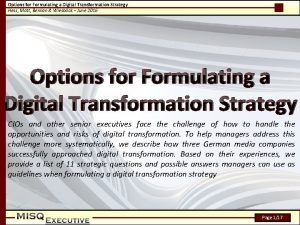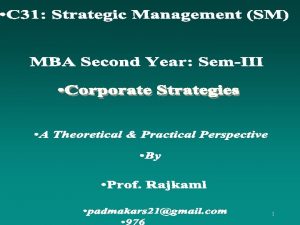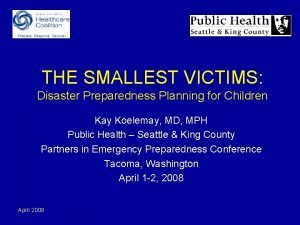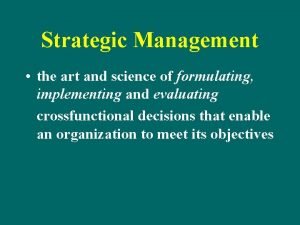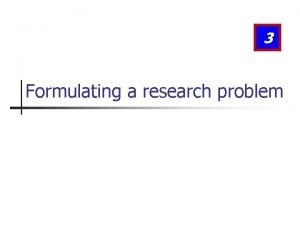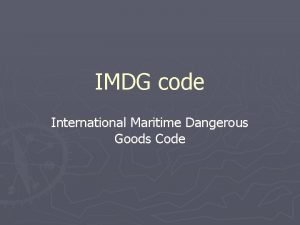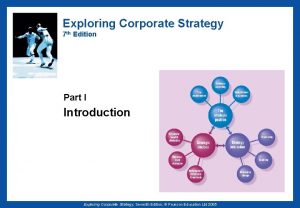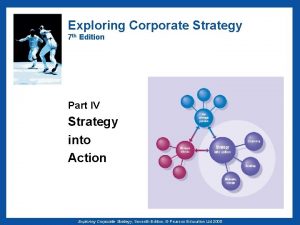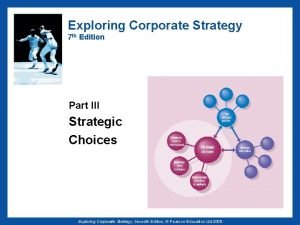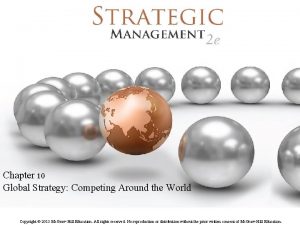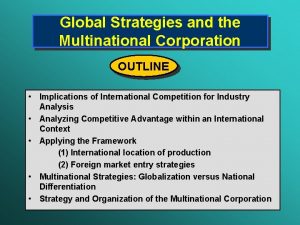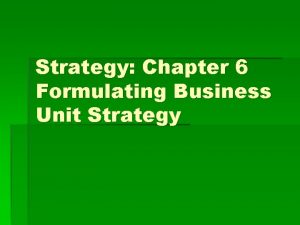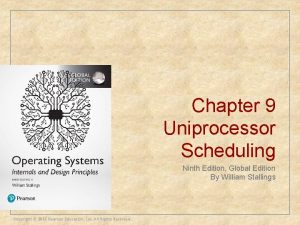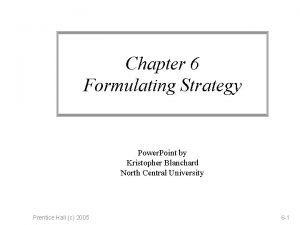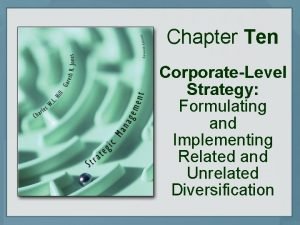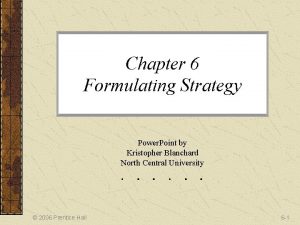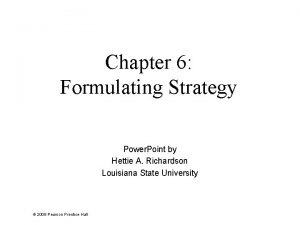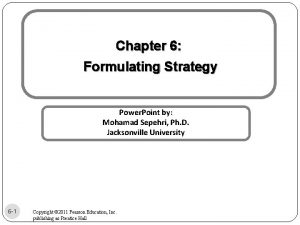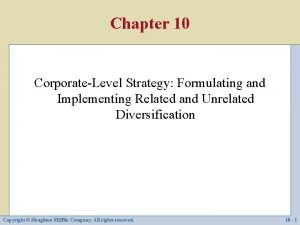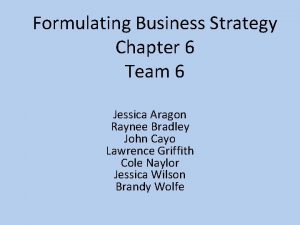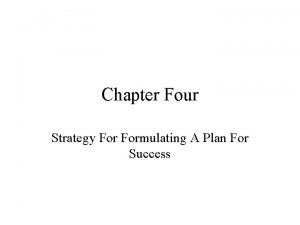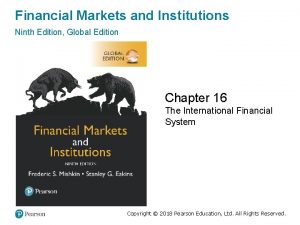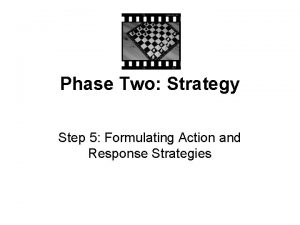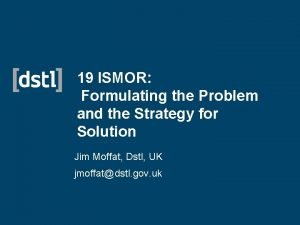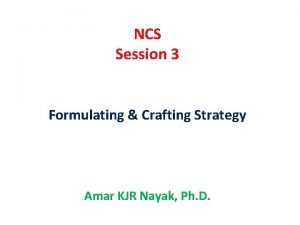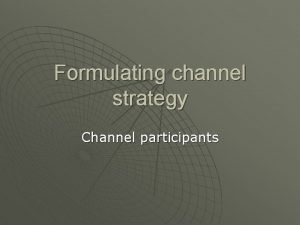Chapter 6 Formulating Strategy Ninth Edition 6 1
























































- Slides: 56

Chapter 6: Formulating Strategy Ninth Edition 6 -1 Copyright © 2017 Pearson Education, Inc.

Chapter Learning Goals 6 -2 1. To understand the reasons companies engage in international business 2. To learn the steps in global strategic planning, including assessing entry strategies for different markets 3. To become familiar with strategic planning for emerging markets Copyright © 2017 Pearson Education, Inc.

Opening Profile: Amazon, e. Bay, and Flipkart Bet Big on India Amazon entered India in 2013 and plans to dominate the e-retailing marketplace before Walmart expands its e-commerce EBay has been in India since 2005 and has invested large amounts in Snapdeal to grow its market share there Flipkart, India’s biggest e-retailer is injecting $1 billion of fresh capital there The Indian online retail market has grown at 56 percent annually for seven years and will grow to $8. 3 billion in 2015 6 -3 Copyright © 2017 Pearson Education, Inc.

Chapter Learning Goals To understand the reasons companies engage in international business. 6 -4 Copyright © 2017 Pearson Education, Inc.

Strategic Planning and Strategy 6 -5 Strategic Planning • More complex than domestic strategic planning because of more complex variables Strategy • The basic means by which the firm competes Copyright © 2017 Pearson Education, Inc.

Reasons for Going International Reactive/Defensive 6 -6 Proactive/Aggressive Globalization of Economies of scale competitors Trade barriers Regulations and restrictions Customer demands Growth opportunities Copyright © 2017 Pearson Education, Inc. Resource access and cost savings Incentives

Comparative Management In Focus: Global Companies Take Advantage of Opportunities in South Africa: ranked the leading economy in Africa and 14 th out of 26 emerging economies, behind China, India, and Russia Businesses are taking advantage of opportunities because of the legal protection of property high labor productivity low tax rates reasonable regulation low level of corruption 6 -7 good access to credit Copyright © 2017 Pearson Education, Inc.

South Africa 6 -8 Copyright © 2017 Pearson Education, Inc.

Strategic Management Process 6 -9 Copyright © 2017 Pearson Education, Inc.

The global formulation process parallels the domestic 10 process, but it is more complex because of the greater difficulty in gaining accurate and timely information, the diversity of geographic locations, and the differences in political, legal, cultural, market, and financial processes. The strategic planning process identifies potential opportunities for (1) appropriate market expansion, (2) increased profitability, and (3) new ventures for exploiting strategic advantages. This figure demonstrates the process is comprised of two primary phases: planning and implementation. In reality, the stages depicted in this slide are rarely so linear. Instead, the process in continuous and intertwined. Copyright © 2014 Pearson Education, Inc. publishing as Prentice Hall

Chapter Learning Goals To learn the steps in global strategic planning, including assessing entry strategies for different markets 6 -11 Copyright © 2017 Pearson Education, Inc.

Steps in Developing International and Global Strategies Mission and Objectives Environmental Assessment and Scanning Internal and Competitive Analysis Global Integrative and Entry Strategy Alternatives Evaluate Entry Strategy alternatives 6 -12 Copyright © 2017 Pearson Education, Inc. Decide on Strategy

Step 1: Establish Mission and Objectives Marketing Producti on Finance 6 -13 • Worldwide, regional, national market share • Production volume • Economies of scale • Tax burden • Capital structure Copyright © 2017 Pearson Education, Inc.

Step 1: Establish Mission and Objectives • ROA • ROE Profitability • ROI R&D 6 -14 • Global patents Copyright © 2017 Pearson Education, Inc.

Step 2: Assess External Environment 6 -15 Copyright © 2017 Pearson Education, Inc.

Under the Lens: Mc. Donalds in Russia: A Political Pawn • In 2014, the Russian government consumer watchdog, closed four Mc. Donald’s restaurants in Moscow and conducted unscheduled checks on branches throughout the country • Mc. Donalds had been in the news, when Russia annexed Crimea, because management closed outlets in Crimea to protect employees • Mc. Donald’s has 37, 000 employees in 440 branches in Russia. It is concerned about future growth because of government interference and crackdowns on business 6 -16 Copyright © 2017 Pearson Education, Inc.

Environmental Scanning Variables 6 -17 Political and Economic Risk Technologica l, Legal, Physical Restraints Internation al Competitio n Nationalism Copyright © 2017 Pearson Education, Inc.

Institutional Effects on International Competition 6 -18 Attractivenes s of Overseas Markets • The extent to which countries have institutions to promote the rule of law to outside investors Entry Barriers and Industry Attractivene ss • Creating barriers to entry in certain industries and making those industries more attractive (profitable) for incumbent firms Copyright © 2017 Pearson Education, Inc.

Institutional Effects on International Competition Antidumpin g as an Entry Barrier 6 -19 Copyright © 2017 Pearson Education, Inc. • The current U. S. antidumping laws place a foreign entrant at a disadvantage if accused of “dumping”.

Antidumping Anti-dumping. If a company exports a product at a price lower than the price it normally charges on its own home market, it is said to be “dumping” the product. The WTO Agreement does not regulate the actions of companies engaged in "dumping". Its focus is on how governments can or cannot react to dumping — it. 20 Copyright © 2014 Pearson Education, Inc. publishing as Prentice Hall

Step 3: Analyze Internal Factors Internal Analysis Key Success Factors: Technological Competitive Analysis SWOT analysis capability: Apple Distribution channels: Wal-Mart Promotion capabilities: Disney 6 -21 Copyright © 2017 Pearson Education, Inc. Distinctive competencies Comparative advantage E-Business

Step 3: Analyze Internal Factors There a variety of public information 22 sources available to provide information to organizations. Company’s also use clipping services. However, internal sources of information are usually preferable because they help eliminate unreliable information from secondary sources. Mitsubishi Trading Company employees more than 60, 000 market analysts worldwide who gather, analyze, and feed market information to the Copyright © 2014 Pearson Education, Inc. publishing as Prentice Hall parent company.

Step 3: Analyze Internal Factors Internal analysis involves weighing the 23 company’s options relative to its strengths and weaknesses. Company’s must identify their key success factors and determine how they can help the firm exploit foreign opportunities. This slide shows several examples of key success factors for wellknown companies. All companies have strengths and weaknesses, the. Inc. challenge is to identify both Copyright © 2014 Pearson Education, publishing as Prentice Hall and take appropriate action.

Step 3: Analyze Internal Factors At this point executives must assess the firm’s capabilities and key success factors compared to those of its competitors. This process enables strategic planners to determine where the firm has distinctive competencies that might lead to sustainable competitive advantage. Most companies develop their strategies around these distinctive competencies, or key strengths. They are usually difficult for competitors to imitate. This strategic formulation is often called SWOT analysis. 24 Copyright © 2014 Pearson Education, Inc. publishing as Prentice Hall

Strategic Decision. Making Models 6 -25 Copyright © 2017 Pearson Education, Inc.

Step 4: Evaluate Global and International Strategic Alternatives Regionalization/L ocalization Global Integrati ve Global Alternativ e Strategies 6 -26 Copyright © 2017 Pearson Education, Inc.

International Strategic Alternatives The strategic planning process 27 involves considering the advantages (and disadvantages) of various strategic alternatives in the light of the competitive analysis. While weighing alternatives, managers must take into account the goals of their firms and the competitive status of other firms in the industry. Copyright © 2014 Pearson Education, Inc. publishing as Prentice Hall

Pressures to Globalize Increasing competitive clout resulting from regional trading blocs Declining tariffs Information Technology explosion 6 -28 Copyright © 2017 Pearson Education, Inc.

Pressures to Globalize Depending on the size of the firm, managers must consider two levels of strategic alternatives. The first is global strategic alternatives, which determine the overall approach to the global marketplace a firm wishes to take. This level primarily applies to MNCs. The second level is entry strategy alternatives. Global strategies or globalization refer to the establishment of worldwide operations and the development of standardized products and marketing. The rationale is to compete by establishing worldwide economies of scale, offshore manufacturing, and international cash flows. 29 Copyright © 2014 Pearson Education, Inc. publishing as Prentice Hall

Pressures to Globalize The impetus for globalization usually includes (1) 30 increasing competitive clout resulting from regional trading blocs, (2) declining tariffs, which encourage trading across borders and open up new markets, and (3) the information technology explosion, which makes the coordination of worldwide operations easier and increases the commonality of consumer tastes. There are, however, challenges associated with a global strategy. It makes the firm more vulnerable to environmental risk, it is difficult to manage, companies often lose some of their original identities through denationalization, and there can be a lack of flexibility Copyright © 2014 Pearson Education, Inc. publishing and Hall responsiveness at the local level. as Prentice

Regionalization/Localization Local markets are linked together within a region, allowing local responsiveness The impetus: Unique consumer preferences Domestic subsidies New production technologies 6 -31 Copyright © 2017 Pearson Education, Inc.

Cage Distances Between Countries Cultural Distance Administrative Distance Geographical Distance Economic Distance 6 -32 Copyright © 2017 Pearson Education, Inc.

Cage Distances Between Countries Ghemawat argues that strategy cannot be decided either on a country-by-country basis or on a one-size-fits-all-countries basis but, rather, that both the differences and the similarities between countries must be taken into account. He bases his perspectives on the cultural, admin- istrative, geographic, and economic (CAGE) distances between countries, 33 Copyright © 2014 Pearson Education, Inc. publishing as Prentice Hall

Global Integrative Strategies Full vertical and horizontal integration Example: Dell Factories in Ireland, Brazil, China, and so on Assembly and delivery system from 47 locations around the world Little inventory, ability to change operations quickly 6 -34 Copyright © 2017 Pearson Education, Inc.

Global Integrative Strategies Many MNCs have developed their global operations to the point of full integration, including suppliers, productive facilities, marketing and distribution outlets, and contractors around the world. Dell is an example of a fully integrated company. 35 Copyright © 2014 Pearson Education, Inc. publishing as Prentice Hall

Change in World Internet Usage as of Q 2 2014 6 --36 Copyright © 2017 Pearson Education, Inc.

E-Business for Global Expansion 6 -37 Copyright © 2017 Pearson Education, Inc.

E-Global or E-Local? E-Global When: Trade is global in scope Business does not involve delivering orders When the business model can be easily hijacked by local competitors 6 -38 Copyright © 2017 Pearson Education, Inc. E-Local When: Production and consumption are regional in scope Customer behavior and market structures differ across regions, but are similar within a region Supply-chain management is very important to success

Step 5: Evaluate Entry Strategy Alternatives Exporting Licensing Franchising Contract Manufacturing Offshoring Service Sector Outsourcing Turnkey Operations Management Contracts International Joint Ventures Fully Owned Subsidiaries E-business 6 -39 Copyright © 2017 Pearson Education, Inc.

Step 5: Evaluate Entry Strategy Alternatives As a relatively low-risk alternative, many small firms seldom go beyond exporting, and large firms use this avenue for many of their products. Experienced firms may establish an export department or hire an export management company. When setting up an export system, particular care must be given to choosing a distributor, as many countries have regulations that make it difficult to remove an inefficient distributor. Jordan Toothbrush is a small toothbrush manufacturer in Norway. 40 Copyright © 2014 Pearson Education, Inc. publishing as Prentice Hall

Step 5: Evaluate Entry Strategy Alternatives Licensing grants the rights to a firm in the host country to 41 either produce or sell a product, or both. The agreement involves the transfer of rights to patents, trademarks, or technology for a specified period of time in return for a fee paid by the licensee. Anheuser-Busch has licensees in England, Japan, Australia, and Israel. Licensing is relatively low risk because it requires little investment. It makes sense in countries where entry by other means is prohibited and for products in the mature phase of the life-cycle—when competition is intense, margins decline, and production is relatively standardized. It also is useful for firms with rapidly changing technologies, diverse product lines, and small firms with few financial and managerial resources for Copyright © 2014 Pearson Education, Inc. publishing direct. Hallinvestment abroad. as Prentice

Step 5: Evaluate Entry Strategy Alternatives With franchising, a franchisor licenses a company’s trademark, products and services, and operating principles to the franchisee for an initial fee and ongoing royalties. Franchising also is relatively low risk and is ideal for small businesses. Contract manufacturing involves contracting for the production of finished goods or component parts. These goods are then imported to the home or other countries for assembly or sale, or they are sold in the host country. Nike is an example of a company that uses contract manufacturing. 42 Copyright © 2014 Pearson Education, Inc. publishing as Prentice Hall

Step 5: Evaluate Entry Strategy Alternatives Offshoring occurs when a company moves one or all 43 of its factories to another country. Offshoring provides access to foreign markets and lower production costs, while avoiding trade barriers. According to the US Commerce Department, about 90% of the outcomes from US-owned offshore factories is sold to foreign consumers. Service sector outsourcing is outsourcing “whitecollar” jobs. The text lists several examples companies outsourcing white collar jobs. Historically, India has been a primary location for IT outsourcing. However, as wages in India are beginning to rise, many Copyright © 2014 Pearson Education, Inc. publishing as Prentice Hall companies are beginning to outsource to the

Under the Lens: Ft article, “Modern Mexico Reshoring: Location and young workforce prove attractive” • After manufacturing in China from 2000 -2010, Mexico is a destination for US companies “reshoring”, as Chinese labor costs increase • Mexico has reshoring advantages: • a young, skilled workforce • the right time zone for US companies • successful industrial clusters • A study warned that the country is squandering its advantages because the government is not promoting Mexico as a relocation destination 6 -44 Copyright © 2017 Pearson Education, Inc.

Service Sector Outsourcing 6 -45 Copyright © 2017 Pearson Education, Inc.

2014 Global services location index ranks In a survey 46 of the global outsourcing landscape in 50 countries and those countries’ potential across three major categories —financial attractiveness, people skills and availability, and business environment—A. T. Kearney consultants identified the top countries for delivering IT, BPO, and voice services, shown in Exhibit 6 -8. The findings confirm that Asia continues to dominate, in particular in India, due to its highly educated and English-language staff availability. Latin America as a region also does well, and Central Europe offers mature industry and highly skilled workers. Copyright © 2014 Pearson Education, Inc. publishing as Prentice Hall

Management in Action: Strategic Planning for Emerging Markets Increasing business opportunities for companies wanting to set up operations in or export to emerging markets Different countries are at different levels of development and have different risk/return profiles Usually entails higher risk 6 -47 Copyright © 2017 Pearson Education, Inc.

Management in Focus: Strategic Planning for Emerging Markets One size does not fit all: different infrastructure, socio-economic and regulatory challenges, different environmental and geographic constraints Potential for innovation, not just new customers 6 -48 Copyright © 2017 Pearson Education, Inc.

Top Three Strategic Objectives 6 -34 Copyright © 2017 Pearson Education, Inc.

Number of Functions 6 -50 Copyright © 2017 Pearson Education, Inc.

New Strategies for Emerging Markets 6 -51 Copyright © 2017 Pearson Education, Inc.

Operating Model for Emerging Markets 6 -37 Copyright © 2017 Pearson Education, Inc.

Disconnected Governance Model 6 -38 Copyright © 2017 Pearson Education, Inc.

Step 6: Decide on Strategy The strategic choice of one or more of the entry strategies depends on: • a careful evaluation of the advantages and disadvantages of each in relation to the firm’s capabilities and resources • critical environmental factors • the contribution that each choice would make to the over- all mission and objectives of the company 6 -54 Copyright © 2014 Pearson Education, Inc.

The Influence of Culture on Strategic Choice and Timing Entry China and Japan have longer-term time horizons than the United States High uncertainty avoidance cultures (e. g. , Latin American, African countries) prefer non-equity modes of entry High power distance cultures (e. g. , Arab countries and Japan) tend to use more equity modes of entry abroad 6 -55 Copyright © 2017 Pearson Education, Inc.

All rights reserved. No part of this publication may be reproduced, stored in a retrieval system, or transmitted, in any form or by any means, electronic, mechanical, photocopying, recording, or otherwise, without the prior written permission of the publisher. Printed in the United States of America. Copyright © 2017 Pearson Education, Inc. 56
 Psychology ninth edition in modules
Psychology ninth edition in modules Macroeconomics mankiw 9th edition
Macroeconomics mankiw 9th edition Anatomy and physiology edition 9
Anatomy and physiology edition 9 General adaptation syndrome
General adaptation syndrome Social psychology ninth edition
Social psychology ninth edition Biology ninth edition
Biology ninth edition Child development laura berk 9th edition
Child development laura berk 9th edition Child development 9th edition
Child development 9th edition Lysanx
Lysanx Psychology ninth edition in modules
Psychology ninth edition in modules David myers psychology 9th edition
David myers psychology 9th edition Biology ninth edition
Biology ninth edition Campbell ninth edition
Campbell ninth edition Options for formulating a digital transformation strategy
Options for formulating a digital transformation strategy Formulating corporate level strategy
Formulating corporate level strategy The sixth commandment catholic
The sixth commandment catholic The sixth and ninth commandments
The sixth and ninth commandments Greek root light
Greek root light Ramadan information
Ramadan information William blount 9th grade academy
William blount 9th grade academy Lower ninth ward
Lower ninth ward Classical accompaniment of poulet maryland
Classical accompaniment of poulet maryland Ninth district pta
Ninth district pta Mis chapter 6
Mis chapter 6 Using mis (10th edition) 10th edition
Using mis (10th edition) 10th edition Strategic management is an art or science
Strategic management is an art or science Research topics and their objectives
Research topics and their objectives Formulating a thesis
Formulating a thesis Community action plan
Community action plan Formulating a research design
Formulating a research design Formulating a claim
Formulating a claim Research problem formulation
Research problem formulation Unit 1 materials formulating matter
Unit 1 materials formulating matter What is the objective of the imdg code
What is the objective of the imdg code Formulating thesis statement
Formulating thesis statement Formulating and clarifying the research topic
Formulating and clarifying the research topic Formulating and clarifying the research topic
Formulating and clarifying the research topic Formulating research methodology
Formulating research methodology Formulating solutions
Formulating solutions Formulating and clarifying the research topic
Formulating and clarifying the research topic Scope and limitation of the study example
Scope and limitation of the study example Formulating and clarifying the research topic
Formulating and clarifying the research topic Formulating and clarifying the research topic
Formulating and clarifying the research topic Exploring corporate strategy 7th edition
Exploring corporate strategy 7th edition Exploring corporate strategy 7th edition
Exploring corporate strategy 7th edition Exploring corporate strategy 7th edition
Exploring corporate strategy 7th edition Corporate strategy and business strategy
Corporate strategy and business strategy Multi domestic strategy
Multi domestic strategy Chase strategy in aggregate planning
Chase strategy in aggregate planning Transnational strategy vs global strategy
Transnational strategy vs global strategy Aligning hr strategy with business strategy
Aligning hr strategy with business strategy Liability of foreignness
Liability of foreignness Process of crafting and executing strategy
Process of crafting and executing strategy Strategy formulation vs strategy implementation
Strategy formulation vs strategy implementation Listening strategies activities
Listening strategies activities Directional strategies in strategic management
Directional strategies in strategic management International or multinational
International or multinational













